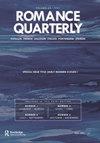Celebration and ambivalence in Lorca’s “Oda a Salvador Dalí”: Apollo and Dionysus, Noucentisme and Cadaqués, and the rose
IF 0.2
3区 文学
0 LITERATURE, ROMANCE
引用次数: 0
Abstract
Abstract Lorca’s “Oda a Salvador Dalí” ranges over a variety of themes. It addresses Dalí’s then involvement with styles of painting associated with Cubism and Purism, which in the poem are described in Nietzschean terms as an espousal of the Apollonian and the suppression of the Dionysian. At the same time, the “Oda” does not fully endorse these modes of avant-garde painting and the distinctly Apollonian turn that Lorca sees in them. A certain hesitation and a preference for a more moderate approach—to art, and to life—are communicated via different symbols, principally the village of Cadaqués (with which Dalí was strongly connected) and the rose. The earlier artistic style of Noucentisme with its strong neoclassical tendency is associated with Cadaqués, situated on the coast of the Mediterranean Sea, while the location and character of the village itself also exemplify the kind of moderation and balance extolled by the “Oda.” This also applies to the rose, whose rich symbolism encompasses classical beauty and a kind of natural perfection again in accord with the eschewing of the extremes of Apollonianism. As much as Lorca admires Dalí for his striving toward his artistic goals, he is also concerned that those goals imply a kind of coldness and detachment that could eclipse their close personal relationship.洛尔卡的《Oda a Salvador Dalí》中的庆祝与矛盾:阿波罗与狄俄尼索斯,Noucentisme与cadaquacoms,以及玫瑰
摘要Lorca的“Oda Salvador Dalí”涵盖了各种主题。它讲述了达利当时参与立体主义和纯粹主义的绘画风格,在这首诗中,尼采将其描述为对阿波罗主义的拥护和对酒神主义的压制。同时,“奥达”并没有完全认可这些先锋绘画模式,以及洛卡在其中看到的明显的阿波罗式的转变。对艺术和生活的某种犹豫和对更温和的方式的偏好通过不同的符号来传达,主要是Cadaqués村(达利与之有着密切的联系)和玫瑰。新古典主义早期的艺术风格及其强烈的新古典主义倾向与位于地中海沿岸的Cadaqués有关,而村庄本身的位置和特点也体现了“Oda”所推崇的那种温和和平衡,其丰富的象征意义包含了古典美和一种自然的完美,再次符合对阿波罗主义极端的回避。尽管洛尔卡钦佩达利为实现自己的艺术目标而努力,但他也担心这些目标意味着一种冷漠和超然,可能会掩盖他们亲密的个人关系。
本文章由计算机程序翻译,如有差异,请以英文原文为准。
求助全文
约1分钟内获得全文
求助全文
来源期刊

ROMANCE QUARTERLY
LITERATURE, ROMANCE-
CiteScore
0.30
自引率
50.00%
发文量
18
期刊介绍:
Lorca and Baudelaire, Chrétien de Troyes and Borges. The articles in Romance Quarterly provide insight into classic and contemporary works of literature originating in the Romance languages. The journal publishes historical and interpretative articles primarily on French and Spanish literature but also on Catalan, Italian, Portuguese, and Brazilian literature. RQ contains critical essays and book reviews, mostly in English but also in Romance languages, by scholars from universities all over the world. Romance Quarterly belongs in every department and library of Romance languages.
 求助内容:
求助内容: 应助结果提醒方式:
应助结果提醒方式:


